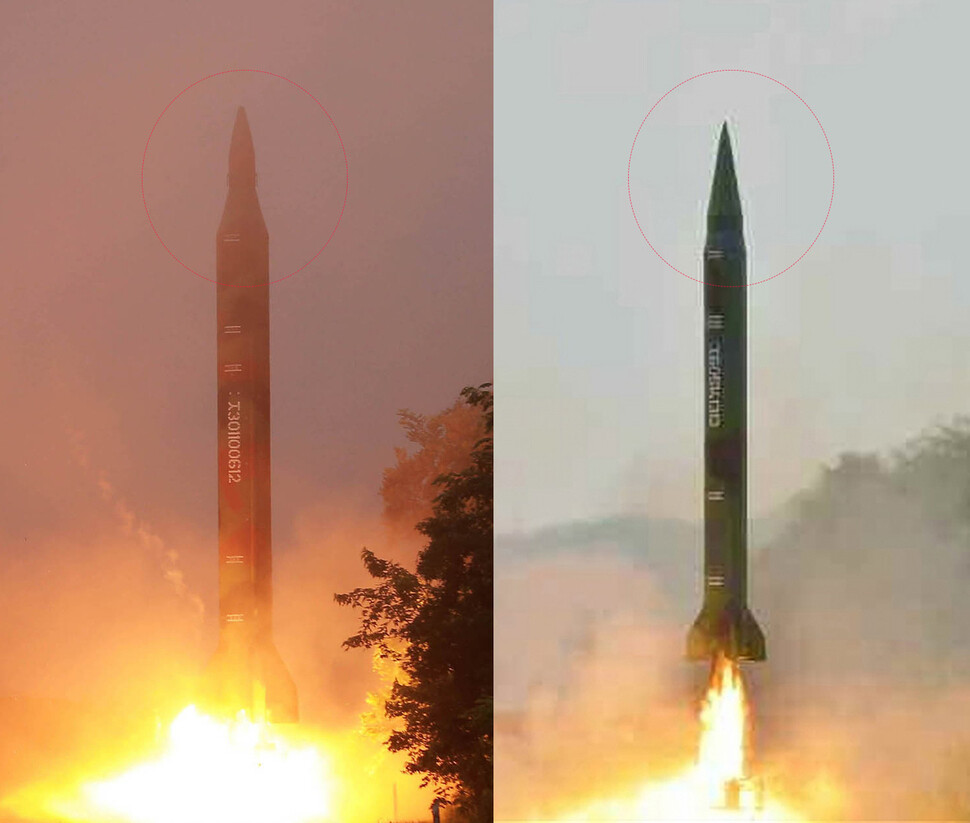hankyoreh
Links to other country sites 다른 나라 사이트 링크
Scud or Nodong? Experts puzzle over N. Korean missile launch

A Nodong or an extended-range Scud missile?
A debate is raging over what type of ballistic missile North Korea launched on Sept. 5. The Ministry of National Defense announced at the time that the North had launched three Nodong missiles, which had flown just over 1,000 km over the East Sea.
The following morning, North Korea published an image of the launch in its Rodong Sinmun newspaper. The conical warhead for the missile in that photograph was more reminiscent of a Scud, differing from the “baby-bottle-neck” shape of the Nodong. The transporter erector launcher (TEL) in the photograph also appeared to be the four-wheeled vehicle reportedly used for the Scud, rather than five-wheeled kind used with previous Nodong missile launches.
Contrary to the announcement by the Ministry of National Defense, experts suggested the missile launched on Sept. 5 may have been the Scud-ER, an improved version of the Scud. Scud ballistic missiles possessed by North Korea include the Scud-B, which has a range of 300 km; the Scud-C, with a range of 500 km; and the Scud-ER (extended range), with a range of 700 to 1,000 km.
“The North Korean missile launched yesterday was slightly different in form from the Nodong missile launched in July,” observed University of North Korean Studies professor Kim Dong-yup.
“From the size and other data, it does appear to be a Nodong missile, but the warhead is from the Scud series,” Kim continued.
“It appears to be one of two things: Either the missile launched yesterday had a Nodong missile warhead that was improved and heavier, or it was a Scud-ER, which is a Scud that has been upgraded to give it longer range.”
In response, the Ministry of National Defense said it had determined the missile fired on Sept. 5 to be an “improved version of the Nodong.”
“There are various types of Nodong missiles,” noted Joint Chiefs of Staff public relations office chief Col. Jeon Ha-kyu in a regular briefing by the Ministry of National Defense on June 6, affirming that the missile was an improved Nodong.
Another military source said, “While the warhead on the missile launched by North Korea yesterday did look like [it was part of] the Scud series, South Korean and US intelligence authorities concluded from analysis of the missile’s trajectory and other factors yesterday that it was a Nodong missile and not a Scud-ER.”
Regarding the four-wheeled TEL, the source said, “It looks like they’re trying to diversify their launch vehicles.”
In a report on Sept. 6, the Rodong Sinmun said the launch exercises were “carried out to review reliability, including the flight safety and guidance accuracy of the improved ballistic rockets that have been place in combat positions, and to judge and review the fighting capabilities of the Hwasong artillery units.” While the report did not specify whether the ballistic rocket was a Nodong or Scud, it did state that its performance had been improved.
The Ministry of National Defense reportedly interpreted North Korea’s decision to change its Nodong missile warhead as possibly part of a development of different warheads toward the future goal of designing a nuclear warhead.
“They may be examining what kind of warhead is appropriate for a nuclear warhead,” said one military official.
Conical warheads typically descend at a faster rate than bottle-neck-shaped warheads at atmospheric reentry, due to their pointed end and streamlined angles. At the same time, the faster descent speed also means much more intense frictional heat and vibrations – which requires more advanced reentry technology.
“It’s possible that improvements to North Korea’s reentry technology have made it capable of attaching a conical warhead to the Nodong missile in place of the previous baby-bottle-neck shape,” said a senior military official.
The implication is that Pyongyang may be increasing the Nodong’s reentry speed to avoid interception by a Terminal High Altitude Area Defense (THAAD) antimissile system or Patriot missile.
By Park Byong-su, senior staff writer
Please direct questions or comments to [english@hani.co.kr]

Editorial・opinion
![[Editorial] Does Yoon think the Korean public is wrong? [Editorial] Does Yoon think the Korean public is wrong?](https://flexible.img.hani.co.kr/flexible/normal/500/300/imgdb/original/2024/0417/8517133419684774.jpg) [Editorial] Does Yoon think the Korean public is wrong?
[Editorial] Does Yoon think the Korean public is wrong?![[Editorial] As it bolsters its alliance with US, Japan must be accountable for past [Editorial] As it bolsters its alliance with US, Japan must be accountable for past](https://flexible.img.hani.co.kr/flexible/normal/500/300/imgdb/original/2024/0417/6817133413968321.jpg) [Editorial] As it bolsters its alliance with US, Japan must be accountable for past
[Editorial] As it bolsters its alliance with US, Japan must be accountable for past- [Guest essay] Amending the Constitution is Yoon’s key to leaving office in public’s good graces
- [Editorial] 10 years on, lessons of Sewol tragedy must never be forgotten
- [Column] A death blow to Korea’s prosecutor politics
- [Correspondent’s column] The US and the end of Japanese pacifism
- [Guest essay] How Korea turned its trainee doctors into monsters
- [Guest essay] As someone who helped forge Seoul-Moscow ties, their status today troubles me
- [Editorial] Koreans sent a loud and clear message to Yoon
- [Column] In Korea’s midterm elections, it’s time for accountability
Most viewed articles
- 1‘Right direction’: After judgment day from voters, Yoon shrugs off calls for change
- 2[Editorial] Does Yoon think the Korean public is wrong?
- 3[Editorial] As it bolsters its alliance with US, Japan must be accountable for past
- 4Where Sewol sank 10 years ago, a sea of tears as parents mourn lost children
- 5Japan officially says compensation of Korean forced laborers isn’t its responsibility
- 6Strong dollar isn’t all that’s pushing won exchange rate into to 1,400 range
- 7[Guest essay] Amending the Constitution is Yoon’s key to leaving office in public’s good graces
- 8[Guest essay] How Korea turned its trainee doctors into monsters
- 9[News analysis] Watershed augmentation of US-Japan alliance to put Korea’s diplomacy to the test
- 10[Column] Brazil, Egypt and Korea